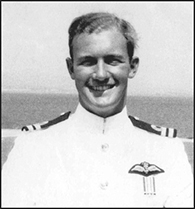

It was September 1960 and I was serving in HMS Ark Royal in 800 Naval Air Squadron (NAS), flying Supermarine Scimitars. One evening I was enjoying a well-earned gin and tonic in the wardroom when I was called to see my boss, Lt Cdr D P (Danny) Norman, and I was expecting him to discuss with me a rather hairy event that occurred earlier in the afternoon.
Although the boss was interested in this episode, he wanted to tell me that I would be joining 700Z Flight, which was to be the IFTU (intensive Flying Trials Unit) for the Buccaneer S1, when it formed in January 1961. This was exciting news for me.
Once I was settled into 700Z Flight at Lossiemouth, I was anxious to get my hands on the Buccaneer, but patience was required, as our first aircraft did not arrive for some months. Time was not wasted however and I managed to get a lot of flying on a variety of other aircraft, particularly the Hunter T8 and GA 11, Sea Hawk and Vampire T22. Who could ask for more?
700Z Flight was a close-knit outfit with seven pilots initially. The Boss was Alan ‘Spiv’ Leahy and the senior pilot was Ted Anson, a test pilot who had spent time with Blackburn Aircraft Company flying the Buccaneer. The other pilots were very experienced, most with Seahawk and Scimitar experience. Sometime later Bill Foote, an exchange pilot from the US Navy, joined us. All the observers were experienced on a range of aircraft including Sea Venom, Sea Vixen and Gannet and were led by John Coleman, the senior observer.
There was also a very hard working team of engineers, electricians and weapon specialists, led by John Dunphy and Hugh Strange. John was the airframe and engine man and Hugh was the electrical expert. Lt Cdr Bain was also attached to the flight; he was an aeronautical engineer who specialised in analysing data and producing reports on the performance of the aircraft. Also based at Lossiemouth were civilian representatives of all the main suppliers of equipment for the Buccaneer.
I finally got airborne in the Buccaneer on 22 August 1961 with the redoubtable John Coleman in the back seat. We pilots had completed a ground school course with Blackburns but there was no flight simulator available at this time, so one has to admire the observer in the back seat as his pilot took off for the first time. Having been used to the superb acceleration of the Scimitar, it was quite a shock to ‘trundle’ down the runway in the Buccaneer. However, once it got going it flew beautifully.
I immediately felt ‘at home’ in the aircraft and thought it was particularly good at low level. I had spent many hours flying low in the Scimitar and the Sea Hawk, but the Buccaneer was much better, solid as a rock especially at high speed. Until this time I had only flown single-seat combat aircraft and I soon came to appreciate the luxury of flying with another crew member. There was always someone to share problems, and the Buccaneer Mark 1 did present us with the odd problem.
During this period we received our own Hunter T8 fitted with the Buccaneer instrument panel. With just a few pilots to fly it, we used it for ‘continuation’ flying (keeping our hand in) and we could take it away for the weekend to visit friends and family; also on a Saturday morning it was useful in winter to check the snow conditions in the Cairngorms. We also had a Sea Prince, which we used to fetch spares from the Blackburn airfields at Holme-on-Spalding-Moor and Brough.
As the weeks passed, more aircraft arrived and we were able to accelerate the trials programme. The job of the IFTU was to fly the aircraft as hard as possible, to test the aircraft systems and to confirm the specification and performance that Blackburn had guaranteed. This required flying many profiles from sea level to max height and to test the weapons systems. The observer in the back seat did most of the latter. The engineering team also had much work to do, checking the aircraft systems after each flight, sorting out any problems and producing a servicing and maintenance schedule that would allow maximum utilisation of the aircraft when in front-line service in a carrier.
I think it was the fourth aircraft that arrived in all white livery; until then the paint scheme was the normal dark grey on top and white underneath. Apparently this new paint scheme provided some protection from a nuclear blast…a sobering thought.
One of the problems we had to deal with in the early days was malfunctioning IGVs (inlet guide vanes). Their job was to channel the air into the engine and sometimes they would slam shut, which could be quite disconcerting. I remember leading three aircraft on a low-level sortie round the Western Highlands when one of the student pilots called out in a strangled voice that the IGVs on both engines had closed. After what must have seemed an age to him, the vanes opened again and we completed the flight without further incident. Sadly the following week, this student took himself off the course and pursued other avenues. I admired him for doing this, but was sad because I think he would have made the grade.
The other troubling problem we encountered was when the BLC (boundary layer control) or ‘blow’ system failed. In the landing configuration this could be very tricky, as the approach and landing speed we used was dependent on the air from the blow system flowing over the wings, flaps and tail-plane. A BLC failure could result in the wing stalling. As a precaution for a short period, we did not use full flap for landing and consequently we needed a higher landing speed, but this was no good when landing on a carrier so we had no option but to sort out the BLC problems.
The operational requirement for the Buccaneer was to enable the aircraft to counter the threat from the Soviet Sverdlov cruisers by dropping a tactical nuclear bomb on the ship. This bomb was carried in the aircraft’s internal bomb bay and it was released in a toss manoeuvre, which was very straightforward. I had made many similar attacks in the Scimitar, but with the bomb on a wing station and that was much more demanding and exciting.
We had to fly low level at night and this was never simple. Over land you had to know the terrain and, depending on conditions, we would regularly fly at 200 feet. Over the sea however, terrain was not a problem and we flew lower. I think the ‘requirement’ was to be able to fly at 200 feet but the lower you flew, the longer you kept out of the target ship’s radar. We had a neat little traffic light system geared to the radio altimeter to help us maintain height. You dialled in the height you wanted to fly and the lowest I recall using was fifty feet at night. When you were steady at your selected height you had a green light; if you went below this height, you saw a red light and if you went high it was amber. On a dark night if you saw the lights of a fishing boat it was a bit off-putting, as the boat always seemed to be higher than the aircraft. Not an exercise for the faint hearted.
Certainly one of the most enjoyable experiences for me in my flying career was to fly low level through the Highlands on a clear day in the autumn, marvelling at the changing colours of the heather on the hills and mountains, to enjoy the gin clear air which gave unlimited visibility and to see the deep blue-coloured water in the lochs and sea.
On 17 July 1962 the first front-line squadron, 801, formed. I was appointed to this new outfit but sadly I had to be ‘loaned’ back to 700Z Flight as Bill Foote and his observer, Maurice Day, had been killed practising for the Farnborough Air Show in September.
After Bill and Maurice died I had a rather unnerving experience. I regularly visited the Steamboat Inn in Lossiemouth to down a pint or two of ‘Heavy’ and play darts with the locals. As I entered the pub on this particular evening, the whole place went silent. The fishermen who recovered Bill and Maurice from the sea were regulars in the pub and known to me. They thought that I was the pilot of the crashed aircraft and they had just toasted my memory. It was a very spooky feeling!
I had a couple of months to work up the routine for Farnborough. It started with a low fast run down the runway (550 knots), then a pull up with about 5g, when upside down a turn through thirty degrees to the right, then drop the undercarriage when speed permitted, and extend the flaps on the turn to final approach. The idea was to land as soon as possible by making a tight, diving circuit and to be visible to the assembled crowd, thereby demonstrating the manoeuvrability of the aircraft. It was certainly a busy few minutes. I, with Pat Cummuskey in the back seat, duly performed this at Farnborough, thankfully without incident.
The Triumph motorcycle company wanted some publicity and offered the five Buccaneer crews who were performing at Farnborough, five Triumph Tina scooters for the duration of our time at the air show. This was a very attractive proposition though Spiv had his reservations…with good reason. I did not have a motorcycle licence but that did not appear to be a problem. I borrowed an RN Vespa, drove it round the squadron car park then set off to Elgin. I had been briefed on the route to take and to wear my uniform so that the examiner could spot me. A few days later my motorcycle licence arrived in the post. No real surprise that some of the Tinas were less than perfect when we handed them back.
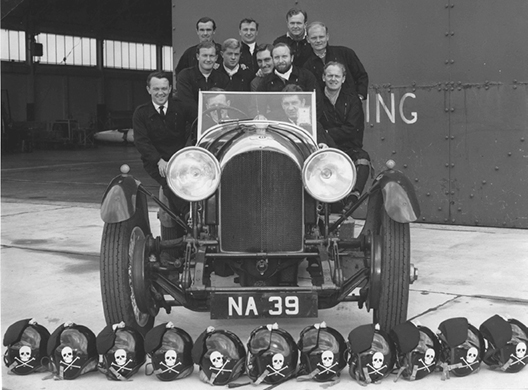
Members of 700Z Flight board Mike Hornblower’s Bentley, NA39.
We had publicity photographs taken before we left Lossiemouth for Farnborough. Mike Hornblower owned an old Bentley with the registration number NA39 (Blackburn’s designation for the aircraft) that was rather neat, so we all piled in for the photographer.
I had been flying the Buccaneer for almost two years before returning to Ark Royal to carry out some deck-landing trials. Deck operations always add a little spice to any flight and it was early in 1963 that I saw the Ark once again, turning into wind and preparing to recover aircraft, as we let down into the circuit in Lyme Bay. I already had many deck landings under my belt, in the Sea Hawk and Scimitar, and I was looking forward to the Buccaneer challenge.
Anyone with deck-landing experience knows that it is not a good idea to regularly catch the first wire. It is the nearest to the aft end of the flight deck and the ramifications of this are obvious. To avoid this I had been in the habit, in the Scimitar, of flying the approach with the ‘meatball’ (the deck landing projector sight) slightly high and this ensured that I pretty well always caught three or four wire. I briefed Geoff Homan, my observer, on what I was going to do as we prepared for our landing. The approach was good and steady, there was minimal movement of the deck so it was an ‘easy’ approach and I remember thinking that the visual aspect was much better than that from the Scimitar cockpit. I was mortified therefore, when we hit the deck and did not feel the comforting retardation you get when a wire is caught. With maximum power on the Gyron Juniors, we still sank a bit as we left the deck and cleaned up for another approach. I felt the flush of embarrassment for making a bolter, but the lesson was learnt – meatball right in the middle for the Buccaneer.
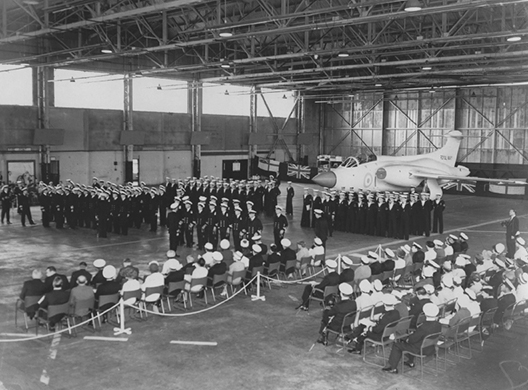
801 Squadron commissioning ceremony at Lossiemouth.
I enjoyed operating the Buccaneer from a carrier. The catapult launch from the flight deck was sometimes a bit critical depending on the aircraft weight, air temperature and wind speed over the deck. The Gyron Junior engines were not over powerful and if an engine failed during the launch you had a problem. The approach and landing was straightforward. Line up (there was no cross wind), fly the meatball and nail the speed. An audio signal told you when you were flying at the correct speed and a warning audio told you if you were getting below the datum speed.
We operated from the Ark Royal for nearly a month before returning to Lossiemouth and it was incident free for me until near the end of this period. We were operating in the Bay of Biscay and on the day in question we were going to make a four-aircraft strike on a target in France and then fly on to Yeovilton. All went well until we were approaching the airfield. It was overcast, and raining, with a 200-foot cloud base. I was concentrating on the radar controller’s instructions and was about 800 foot on final approach with my gear down and selecting flap. In the Buccaneer, when the flap goes down there is a counter-balancing tail-plane flap that has to go up. If it does not, the aircraft continues to nose forward with dire consequences.
This is what happened to me. I immediately stopped the flaps extending, carried out a 360-degree turn to the right under radar control, sorted out the flap situation on the standby panel and came back on to finals. In the end the landing was no problem but for five minutes it had been quite frightening.
About three months later 801 Squadron was preparing to embark in Victorious and would be the first operational Buccaneer squadron to go to sea. I was looking forward to this sea time very much, but it was not to be. It had been decided that there was a requirement for a QFI, with Buccaneer experience, to help run Buccaneer pilot training and I was selected for this job. I certainly did not volunteer to become an instructor as I was enjoying life as a squadron pilot and would rather have stayed with 801 Squadron, but orders are orders.
Consequently in July 1963 I joined 219 Course at the Central Flying School (CFS), Little Rissington, back in the tender arms of the RAF, who had taught me to fly a few years earlier.
The Jet Provost was a delightful aircraft to fly and I certainly benefited from the CFS course. The instruction was excellent in both the flying and ground school and the RAF should be proud of this facility. The CFS was kind enough to give me a trophy before they packed me off back to Lossiemouth. If I had been given a choice at this stage, I would have liked to do some basic flying instruction, being newly qualified and with a new set of skills, but I was also perfectly happy to return to the Buccaneer world.
A very busy time followed. I put the trainee pilots through the simulator course, I flew with them in the Hunter T8 equipped with Buccaneer instruments and, when I felt they were ready, I sat in the back seat on their first three trips. This was overkill really and I quickly reduced this to their first trip and if this was satisfactory, an experienced observer flew with them on the remaining familiarisation sorties.
On one memorable day in August 1964 I sat in the back seat twice, both flights with first-tour student pilots. During the first flight we had a hydraulic failure and on the second an engine fire which led to a single-engine landing. The student pilots handled both emergencies very well and this gave me confidence that the conversion training we had set in place was sound. All in a day’s work!
29 November 1965 was a normal working day at Lossiemouth but snow and freezing temperatures had not allowed any flying. I was 736 Squadron’s duty officer so when air traffic rang, I took the call. They asked me to arrange a weather check to the north of the Moray Firth to see if any more snow was heading our way. They wanted to know if it was worth restarting snow clearance. Earlier in the day, they had tried to clear the runway but even that was stopped due to the bad weather. I went out to the runway to check the conditions and phoned back to say that in my opinion, Runway 29 was unfit for operations. The second, rather apologetic call from air traffic passed on the message that the request for a weather check was not actually a request. Such is life.
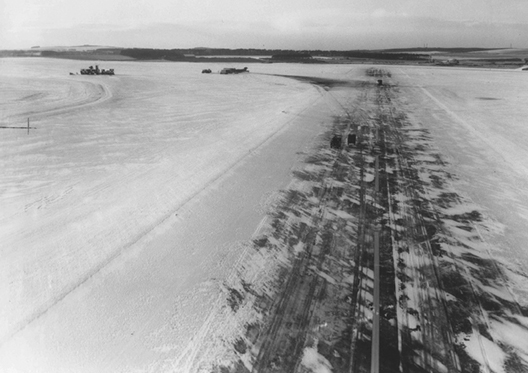
The ‘landing’ on Lossiemouth’s icy runway.
I decided to make the flight myself and Trevor Ling, a trainee observer, joined me. The aircraft was sliding all over the place as we taxied out and with some difficulty we got lined up on R/W 29 and started a rolling take-off as the brakes would not hold the aircraft stationary when power was applied. I had briefed Trevor that if we abandoned the take-off, I would drop the hook and hopefully we would take the wire at the far end of the runway. With some relief we got airborne but then things started to go wrong.
As the Buccaneer QFI and simulator instructor I was pretty familiar with the aircraft systems and the emergency procedures that we taught the trainee crews. The multiple failures that now started to develop were well beyond any sequence of problems that I could have dreamed up.
When I selected gear up, we lost all the instrument indications in the cockpit. We had suffered a total AC failure and the back-up electrical supply also failed. We also lost most of our hydraulics (both main systems and one flying control system). However this was not obvious to me at the time, as I could still control the aircraft. There was some external noise, which I could not place, and apparently this was the nose wheel that had slewed sideways and jammed against the fuselage but obviously there was no cockpit indication.
I levelled off at about 2,000 feet and turned right, over the sea, planning to recover back on to runway 29. What worried me, when I was trying to sort things out, was that I could not find a common thread to the problems we were experiencing. I was half expecting something catastrophic to happen next. It went through my mind that shards of ice, thrown up during the take-off run may have damaged or cut the electric cables in the wheel wells but I was too busy to dwell on that. I glanced over at the airfield and the icy runway did not seem very inviting but it looked considerably better than the grey Moray Firth below us.
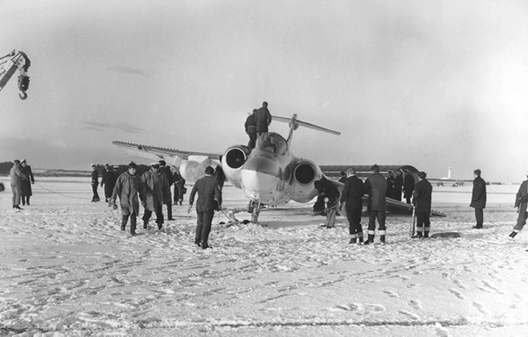
A safe but unorthodox arrival.
I lowered the gear and got reassuring noises, but no undercarriage lights, so I asked air traffic to do a visual check. They replied that all three wheels appeared to be down, so I decided to land. I had no idea of my flap/droop/airbrake situation, so speed control on the approach was a bit of a problem and I was basically flying by ‘feel’. I remember telling Trevor that if I called ‘eject’ it was not a subject for discussion!
On finals, the controls felt pretty slack, so it was with a sense of relief that I put the aircraft down on the end of the runway. I was aware of a bit of sliding, which I was expecting, but then I felt the port wing dropping, which I was not. I held the wing up as long as I could, but as we lost aerodynamic lift down it went and we started curving over the grass to the left. I was mindful all the time that Trevor was a student, but he was very helpful throughout the short flight and got rid of the canopy as we were doing our imitation of a tractor ploughing up the ground. It transpired that the port undercarriage leg was not locked down.
Pay back time. That evening when gathered in the wardroom bar, a few of the crews who had been through the simulator course with me said it could not have happened to a better person – the biter bit! I was about to leave the RN and this was almost my last flight but I was able to make one more, thankfully incident free.
By the autumn of 1965 the Buccaneer world was expanding quite rapidly and many more crews, including the first RAF crew, had been trained.
I left the RN at the beginning of 1966 after ten years as a pilot in the Fleet Air Arm and I felt very grateful for the interesting and sometimes exciting times that I had enjoyed, all the time working with some exceptional people.
My flying days however were not over and I flew for another thirty-two years, but that is another story.
––––––––
For his outstanding flying and airmanship, the Admiralty awarded Bill a Green Endorsement, which read:
‘On 29 November, 1965 at 1400Z Lieutenant W P Ryce, Royal Navy was flying Buccaneer S Mk.1 XN 967 when the aircraft suffered a complete AC power failure. Subsequently Lieutenant Ryce reacted in an extremely professional and competent manner, in dealing with a considerable number of apparently unrelated but critical failures of various systems, which resulted in the aircraft being recovered with the minimum damage.’